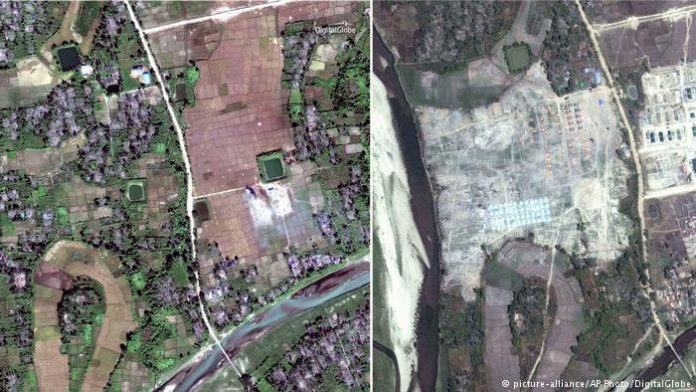Myanmar bulldozed scores of Rohingya villages since November.
Human Rights Watch says the Myanmar authorities’ actions were aimed at covering up evidence of atrocities against Rohingya Muslims. HRW calls on the government to allow UN fact-finding team in to Rakhine state.
New satellite images of Myanmar’s Rakhine state show that the Myanmar authorities have been bulldozing Rohingya Muslim villages that were burned down during the “ethnic cleansing campaign” against the minority, human rights group, Human Rights Watch (HRW) said on Friday.
HRW said at least 55 villages had been razed to the ground since late 2017, after nearly 700,000 Rohingya fled to neighboring Bangladesh to escape military and civilian reprisals in the state.
“The authorities want to cover up evidence of the atrocities and take away the land that belongs to the Rohingya. They want to make it difficult to find graves, weapons used or any other evidence that would connect the crime scene to the criminals,” Brad Adams, HRW’s Asia director, told DW.
“It also reflects the ethnic cleansing mentality of the Burmese authority,” he said.
Adams said the “random” satellite images only reflected a partial picture and fears the situation could be far worse.
The Rohingya, a vast majority of whom are Muslims, have been denied citizenship rights. They are viewed by the local authorities as illegal immigrants from Bangladesh, although many have been living in the region for decades, if not centuries. Myanmar’s Buddhist majority is often accused of subjecting them to discrimination and violence.
Aerial photographs of bulldozed villages in the state were first made public on February 9 when the European Union’s ambassador to Myanmar, Kristian Schmidt, tweeted images of a “vast bulldozed area” south of Maungdaw.
South of Maungdaw, vast bulldozed area of probably former villages, next to new houses. #Rakhine pic.twitter.com/2TMty4auPf
— Kristian Schmidt (@EUAmbSchmidt) February 9, 2018
The Burmese government has said the bulldozing of villages was part of its plan to rebuild the villages with improved roads and houses.
Myanmar’s Social Welfare Minister Win Myat Aye told the AFP news agency earlier this month that “when they [the Rohingya refugees] come back they can live in their place of origin or nearest to their place of origin.”
Myanmar and Bangladesh have agreed to repatriate the Rohingya refugees within two years but HRW says “no refugees have returned to Burma, and Rohinyga continue to flee from Rakhine State.”
United Nations High Commissioner for Refugees Filippo Grandi told the Security Council on February 13 that “conditions are not yet conducive to the voluntary repatriation of Rohingya refugees” as the causes of their flight had not been addressed.
“Rohingya are not going to return for a long time because they do not trust the Burmese authorities,” said HRW’s Adams. “If I were a Rohingya, I would not dare return.”
HRW has called on the Burmese authorities to allow a UN fact-finding team in to Rakhine state.
Myanmar has refused to grant visas to the UN team to prevent it from visiting the affected areas of Rakhine state. It has also blocked independent media and human rights groups from gaining access to the region. The only access so far has been in the form of state-sponsored guided tours.































